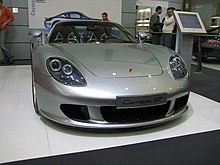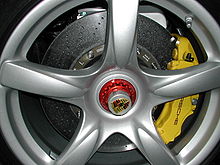-
- The Porsche Carrera GT (Project Code 980) is a mid-engined supercar that was manufactured by Porschebetween 2004–2007 in Leipzig, Germany. Sports Car International named the Carrera GT number one on its list ofTop Sports Cars of the 2000s, and number eight on Top Sports Cars of All Time list.
| Porsche Carrera GT | |
|---|---|
 | |
| Overview | |
| Manufacturer | Porsche |
| Production | 2004–2007 (1,270 produced) |
| Assembly | Leipzig, Germany |
| Body and chassis | |
| Class | Sports car |
| Body style | 2-door roadster |
| Layout | RMR layout[1] |
| Powertrain | |
| Engine | 5.7 L V10 DOHC |
| Transmission | 6-speed manual |
| Dimensions | |
| Wheelbase | 2,730 mm (107 in) |
| Length | 4,613 mm (181.6 in) |
| Width | 1,921 mm (75.6 in) |
| Height | 1,166 mm (45.9 in) |
| Curb weight | 1,380 kg (3,040 lb) |
| Chronology | |
| Predecessor | Porsche 911 GT1 Straßenversion |
| Successor | Porsche 918 SpyderThe Porsche Carrera GT (Project Code 980) is a mid-engined supercar that was manufactured by Porschebetween 2004–2007 in Leipzig, Germany. Sports Car International named the Carrera GT number one on its list ofTop Sports Cars of the 2000s, and number eight on Top Sports Cars of All Time list. |
History
The development of the Carrera GT can be traced back to the 911 GT1 andLMP1-98 racing cars. Due in part to the FIA and ACO rule changes in 1998, both designs had ended. Porsche at the time had planned on a new Le Mans prototype for 1999. The car was initially intended to use a turbocharged flat-6, but was later redesigned to use a new V10 engine, pushing the project back to planned completion in 2000. The V10 was a unit secretly built by Porsche for the Footwork Formula One team in 1992, but later shelved. The engine was resurrected for the Le Mans prototype and increased in size to 5.7 litres. The project was canceled after two days of testing for the first car, in mid-1999, mostly due to Porsche's wish to build theCayenne SUV with involvement from Volkswagen and Audi, thus requiring engineering expertise to be pulled from the motorsports division. It was also speculated that VW-Audi chairmanFerdinand Piëch wanted Audi's new Le Mans Prototype, the Audi R8 not to face competition from Porsche in 2004.
Porsche did keep part of the project alive by using the 5.5 L V10 from the prototype in a concept car shown at the 2000 Paris Motor Show, mainly in an attempt to draw attention to their display. Surprising interest in the vehicle and an influx of revenue provided from the Cayenne helped Porsche decide to produce the car, and development started on a road-legal version that would be produced in small numbers at Porsche's new manufacturing facility in Leipzig. Porsche started a production run of Carrera GTs in 2004, shipping the units with an MSRP of US$448,000. The first Carrera GT went on sale in the United States on January 31, 2004.
Originally a production run of 1,500 cars was planned. However, Porsche announced in August 2005 that it would not continue production of the Carrera GT through to 2006, citing discontinuation was due to changing airbag regulations in the United States. By the end of production on May 6, 2006, more than 1,270 GTs had been sold, with at least 604 of those being in North America.
Design
The Carrera GT is powered by a 5.7 litre V10 engine producing 612 hp (450 kW),whereas the original concept car featured a 5.5 litre version rated at 558 hp (416 kW). Porsche claimed the car would accelerate from 0 to 100 km/h (62.1 mph) in 3.5 seconds with a maximum speed of 330 km/h (205 mph). Actual road tests indicated that the car can accelerate from 0-60 mph (97 km/h) in 3.5 seconds and 0-100 mph (160 km/h) in 6.8 seconds. The Carrera GT was offered with a basic five-colour paint scheme which includes Guards Red, Fayence Yellow, Basalt Black, GT Silver and Seal Grey. Custom colours were later available from the factory. A traditional six-speed manual transmission is the only available transmission. Attached to this gearbox is a beechwood gearknob which pays homage to the wooden gearknob used in the Porsche 917 Le Mans racers. In its second year of production, a carbon fibre knob was also made available.
The Carrera GT has large side inlets and air dams that help cool the large V10 engine framed by the carbon fibre rear bonnet. Fitted with Porsche's latest Carbon fibre-reinforced Silicon Carbide (C/SiC) ceramic composite brake system, the 15-inch (380 mm) SGL Carbon disc brakes make an impressive appearance underneath the 19 inch front and 20 inch rear wheels. Similar to other Porsche models, such as the 911, the GT includes an automated rear wing spoiler which deploys above 70 mph (110 km/h).
The interior is fitted with soft leather. Bose audio system and a navigation system were standard. In typical Porsche fashion, the ignition is to the left of the steering wheel. This placement dates back to the early days of Le Mans racing when drivers were required to make a running start, hop into their cars, start them and begin the race. The placement of the ignition enabled the driver to start the car with his left hand and put it in gear with his right.
Technical specifications
- Engine
- Drivetrain layout: Mid-engine RWD
- Engine type: 68° (Slightly odd firing due to not being 72° Vee angle) V10, aluminium block and heads
- Valve gear: DOHC, 4 valves per cylinder (40 valves total), variable valve timing on intake camshafts, sodium-cooled exhaust valves
- Bore x stroke: 3.86 in (98.04 mm) x 2.99 in (75.95 mm), Nikasil coated bores, forged titanium connecting rods, forged pistons
- Displacement, ci/cc: 349.8/5733
- Compression ratio: 12.0:1
- Max SAE net horsepower: 612 hp (456 kW) at 8,000 rpm
- Max SAE net torque,: 435 lb·ft (590 N·m) at 5,800 rpm
- Specific output, hp/liter: 105.5
- Weight to power, lb/hp: 4.97
- Transmission: 6-speed manual, two plate ceramic dry clutch (PCCC-Porsche Ceramic Composite Clutch)
- Redline: 8,400 rpm
- Body[7]
- Cargo volume: 76 L (2.7 cu ft)
- Ground clearance: 3.4 in (86 mm)
- Fuel consumption for 2004 model
Performance
- Drag Coefficient: 0.39
- 0-60 mph (97 km/h) : 3.8 seconds
- 0-100 mph (160 km/h) : 6.9 seconds
- 1/4 mile: 11.1 seconds @ 133.4 mph (214.7 km/h)
- Top speed: 205 mph (330 km/h)
- elasticity 80–120 km/h : 4.0 seconds (in fifth gear) (official data)
- Braking 100 mph (160 km/h) to 0: 277 feet (84 m)
- Braking 60 mph (97 km/h) to 0: 101 feet (31 m)
- 200 ft (61 m) skidpad, ave g: 0.99
Technology
Notable technology includes a pure carbon fiber monocoque and subframe, dry sump lubrication and inboard suspension. ATR Composites Group of Italy produced and assembled the carbon fiber monocoque and subframe. At speeds above seventy mph, the Carrera GT raises its rear wing into the airstream, to reduce both lift and drag. The size of its radiator is about five times that of a 911 Turbo. Both its front and rear suspensions comprise pushrod actuated shock absorbers and dampers with anti-roll bars.





No comments:
Post a Comment